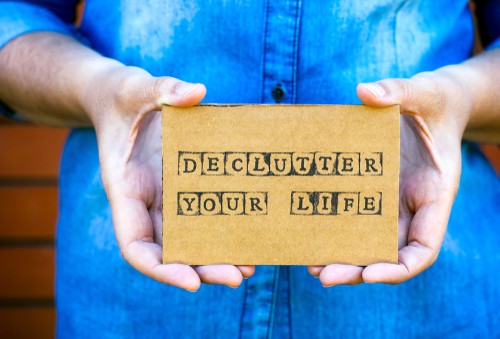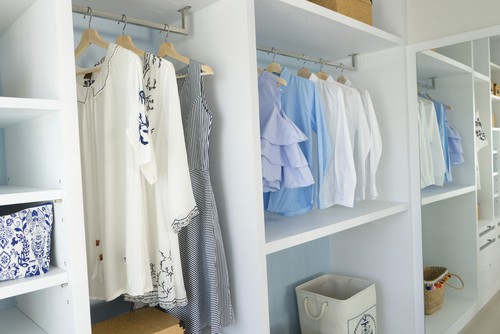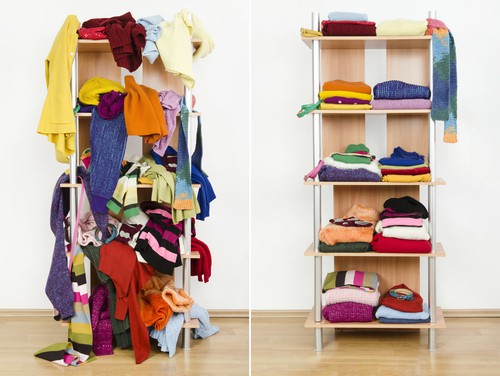Magic Cleaning: Joyful Decluttering with Marie Kondo

Chances are, you’ve been seeing a more minimalist approach to home design, sparked by Japanese expert Marie Kondo. Learn more about her magic cleaning organizing approach seen in the new Netflix series “Tidying Up with Marie Kondo”, based on her bestseller “The Life-Changing Magic of Tidying Up”.
“Tidying Up” with Marie Kondo’s Magic Cleaning
Marie Kondo is regarded worldwide as a decluttering guru. The 34-year-old Japanese artist earned this reputation with her 2014 bestseller “The Life-Changing Magic of Tidying Up”. In the meantime, she has published two more books, which have been translated into 27 languages.
The streaming service Netflix even now offers the series “Tidying Up with Marie Kondo”. In the eight-episode series, she helps people to have a tidy home without any clutter and a whole new attitude to life. So what’s the buzz all about?
Magic Cleaning With A Vision
Before we start with the actual cleaning up, Marie Kondo says it is important to internalize some basic things. Above all, there is a vision: What should my home look like and why should it look like this? It should become very detailed. “I want a clean, beautiful apartment” is not enough.
At the beginning of each episode, together with Marie Kondo, the audience gets to know a family or a single person. She gently tickles out exactly where the family members see cleaning problems. She also encourages the couples to create a vision, such as a storage room that can be converted into mom’s new office. That specific idea is intended to keep motivation high when cleaning out and tidying up. Afterward, Marie Kondo greets the house together with the residents as a ritual. In this way, everyone prepares mentally for what is to come.

KonMari – Decluttering With Joy
Decluttering is basically one question: Keeping or throwing away? According to Kondo, in order to make this decision, we should take every single object we possess in our hands and ask ourselves: Does this item spark joy to me? Then put the “yes” items on a heap, the “no” items end up directly in the garbage bag.
This is how you go through all your possessions according to the KonMari Method. However, the system is essential: instead of going room by room, you should pile items according to category.
Start with your clothes. Is it faster to organize drawer by drawer? Usually, yes, but by creating one impressive pile we’re better able to see the number of things we’ve accumulated over the years. Some people get a huge heap that often shocks them. In the Netflix series, you’ll often hear sentences like “There’s still the price tag! Or “I didn’t even know that I still have that!”
But even though this part of the process takes a while, it helps make the rest of the decluttering process easier. When you realize how easy getting rid of excess clothing can be, you don’t get the feeling of losing them but of freeing yourself from it.
Tidying Up: Taking Or Thanking
Yeah, you read that right: Decluttering with KonMari means you either keep your clothes or toss them out after thanking them for their duty. You can see in some candidate’s faces that they feel a little awkward first, but they get used to it after a while.
After explaining her special way of folding shirts, jeans and other clothes, Marie Kondo leaves the families to themselves for a week. They now have enough time to declutter their wardrobes and all accessories like shoes or jewelry.
Next, you tackle books and papers. While it can be wonderful to have a vast library, do all the books spark joy? If not, donate some of the ones you no longer need. Instead of letting papers and magazines pile up, categorize them into three categories- items to toss immediately, items like bills requiring immediate action, and sentimental papers to keep forever.
Tidying “Komono” and Sentimental Items
Then she comes back for the next step which consists of “Komono” or miscellaneous items. These can include your knickknacks, kitchen supplies, and items in the garage. This is very individual as you can see in the series: baseball cards or decorative items, make-up, or toys.
Maybe the hardest part follows after that: memorabilia like pictures, old diaries, or letters from the deceased. In the show, you can sort clothes quite quickly according to the joy factor, whereas these sentimental items take a little more time to part with.

Everything Has Its Own Place
Kondo then gives helpful magic cleaning tips for subsequent storage. Because the second basic principle is: every object needs a fixed address in the home. After use, everything goes back to its original place. This requires some self-discipline but is basically what helps you prevent new clutter to pile up.
In “Tidying Up with Marie Kondo” she often works with small boxes or dividers within a closet to keep an overview. This keeps everything from getting mixed up. It is therefore important to precisely define the storage space for each person in the household. For example, each family member gets a cupboard with drawers. You then categorize these drawers according to their properties or material: Everything electronic such as cables, external hard drives, light bulbs, or even the camera ends up in the lowest drawer. On top of this comes everything papery: notebooks, handicraft material, letterheads, etc.
KonMari Pleases The Eye
Marie Kondo is also a great advocate of the “beautiful sight”. It is important to her that an apartment doesn’t just look tidy at first glance, while behind locked cupboard doors there is sheer chaos.
So she is an absolute opponent of stacks and piles. In her opinion, you should store everything upright – including clothing, by the way. She has developed a special method for this purpose. Shirts, for example, can be folded so that they can be stored standing. That way, clothes don’t get wrinkles or slip when you pull something out from the bottom. What is difficult to convey in the book “The Life-Changing Magic of Tidying Up” becomes all clearer in the Netflix show where you can watch Kondo practice this folding method for clothes.
On the other hand, you should arrange hanging garments so that the long dresses hang on the left, while short skirts and blouses hang on the right. This results in a line rising from left to right. This triggers positive associations in our brain because they mirror success curves – and that’s what’s supposed to spark joy when you open your closet.

Magic Cleaning – Perfect Motivation For Decluttering
Many people are initially reluctant to face throwing away. But here, too, the KonMari Method knows what to do. Worn clothes, fragile cables – start with objects that have long since been scrap-ready. Even books or clothes that you have bought at some point and never used are part of the heap. Because as hard as it may be – the chance that you will read or wear them again tends towards zero. Those who shy away from throwing everything into the garbage can of course also hand their belongings over to a thrift shop or give to charity.
The same principle applies to the outer packaging, cosmetic samples, or promotional gifts. You can declutter useless bits and pieces that only clog the drawers immediately. And you can also dispose of unpleasant gifts with a clear conscience. You can remove Aunt Irma’s ugly snow globe without guilt if you feel annoyed every time you look at it. That’s the moment when people experience tidying and getting rid of clutter as freeing or in KonMari words: That’s the life-changing magic of tidying up.
You Declutter for Yourself – Not For Others
In the same way, you should refrain from passing on discarded items within the family. Many women pass on their clothes to their sister, for example. According to Kondo, if she doesn’t suffer from financial hardship, you’ll burden her with that. Consider an out-of-fashion old coat that’s been hanging unworn in your closet for years. Does your sister really want it if you hate it? No! If you give it to your sister, it will fall into the category “unpleasant gift”, and then it will then be difficult for her to part with it.
Marie Kondo’s Magic Cleaning Approach
Some aren’t fans of Kondo’s approach to “clean up – in one go, in a short time and perfect.” This sentence runs like a mantra through the “Tidying Up” book. The whole process of sorting out, throwing away, and rearranging should not take longer than six months.
Critics consider this process to be the biggest problem with the KonMari method. Taking six months to organize isn’t always feasible for working parents with children.
Another area sparking discomfort for some Western readers is the basic spiritual idea of Kondo’s concept. Her approach of greeting the house and thanking decluttered objects before discarding them draws heavily from her time spent in a Shinto Temple. But that process doesn’t always resonate with many in the U.S. who aren’t comfortable considering objects in that way.
Nevertheless, the KonMari method offers some helpful tips. The Netflix series “Tidying Up with Marie Kondo” really makes you want to start decluttering immediately. So, why not get started? Spark joy!





